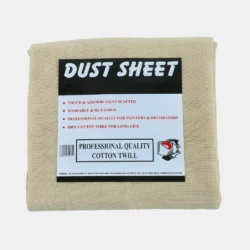-
Standard Cotton Dust Sheets
Standard Cotton Dust Sheets – 12’x9′
£7.74 – £473.23 Select options This product has multiple variants. The options may be chosen on the product page
The Great Cover Up: Cotton Dust Sheets vs. Plastic Drop Cloths
When it comes to DIY projects, protecting your surroundings from dust, spills, and splatters is paramount. But with two main contenders in the protective covering arena – cotton dust sheets and plastic drop cloths – choosing the right one can be a head-scratcher. Fear not, fellow UK DIY enthusiast! This guide will delve into the strengths and weaknesses of both options, helping you select the perfect shield for your next project.
Cotton Dust Sheets: The Breathable Champion
Made from woven cotton or cotton blends, these traditional dust sheets offer a plethora of benefits:
- Breathability: Unlike plastic, cotton allows air to circulate, preventing moisture build-up and potential mildew growth underneath, especially beneficial for protecting wooden floors.
- Absorbency: Cotton excels at soaking up spills and splatters, particularly paint, preventing them from reaching your precious furniture or carpets. This is a lifesaver for messy projects like painting or staining.
- Durability: High-quality cotton dust sheets can be washed and reused countless times, making them an eco-friendly and cost-effective choice in the long run.
- Grip: The textured surface of cotton provides superior traction, reducing the risk of slips and falls compared to the slippery nature of plastic. This is crucial when navigating a room filled with tools and paint cans.
- Drape & Conformity: Cotton’s flexibility allows it to drape and conform to furniture shapes, ensuring better coverage and minimising the gaps where dust and debris can sneak through.
However, cotton dust sheets also have some drawbacks to consider:
- Liquid Penetration: While absorbent, cotton sheets are not waterproof. Large spills or prolonged exposure to liquids can soak through, potentially damaging surfaces underneath.
- Dust Shedding: Cotton can shed some lint and fibres, which might not be ideal for projects requiring a pristine dust-free environment.
- Maintenance: Washing cotton dust sheets adds an extra step to your post-project cleaning routine.
Plastic Drop Cloths: The Lightweight Warrior
Crafted from polyethylene or vinyl, plastic drop cloths offer a distinct set of advantages:
- Waterproof Seal: Plastic acts as an impenetrable barrier against spills, leaks, and moisture. This makes it ideal for protecting surfaces from water damage, especially during plumbing tasks or messy cleaning jobs.
- Lightweight & Disposable: Plastic is significantly lighter than cotton, making it easier to handle and manoeuvre, especially for larger areas. For one-off jobs, disposable plastic sheets offer a convenient and cost-effective option.
- Easy Cleaning: Spills and splatters on plastic can be easily wiped or washed away, saving you time on post-project cleaning.
However, plastic drop cloths come with their own set of limitations:
- Slippery Surface: Plastic’s smooth texture can be a safety hazard, increasing the risk of slips and falls. Extra caution is needed when walking on plastic sheeting.
- Non-Breathable: Plastic traps moisture, which can lead to mildew growth underneath, particularly on wooden floors. Ensure proper ventilation when using plastic for extended periods.
- Less Absorbent: Unlike cotton, plastic won’t soak up spills. Paint splatters can easily spread and become smeared, requiring more cleaning effort.
- Durability & Environmental Impact: Disposable plastic is not eco-friendly and contributes to landfill waste. While some thicker plastic sheeting can be reused, it’s generally less durable than cotton in the long run.
So, Which One Should You Choose?
The ideal choice depends on your specific project needs. Here’s a quick breakdown to help you decide:
Opt for Cotton Dust Sheets if:
- You’re working with paints, stains, or other liquids that need to be absorbed.
- You’re protecting wooden floors where breathability is important.
- You value a reusable and eco-friendly option.
- Slip resistance is a major concern.
Go for Plastic Drop Cloths if:
- You need complete waterproof protection from spills or leaks.
- You’re working on a one-off project where easy disposal is a plus.
- Lightweight and easy manoeuvring are crucial.
- Cost is a primary concern (for disposable options).
Bonus Tip: The Best of Both Worlds!
For ultimate protection, consider combining both materials. Use a plastic sheet as the base layer for complete waterproofing, and then top it off with a cotton dust sheet for absorbency and breathability. This is a great option for extensive renovation projects or when working with particularly messy materials.
Remember: When shopping for cotton dust sheets, look for heavier weights and tightly woven fabrics for better durability and minimal lint shedding. For plastic drop cloths, consider purchasing a thicker, reusable option.




